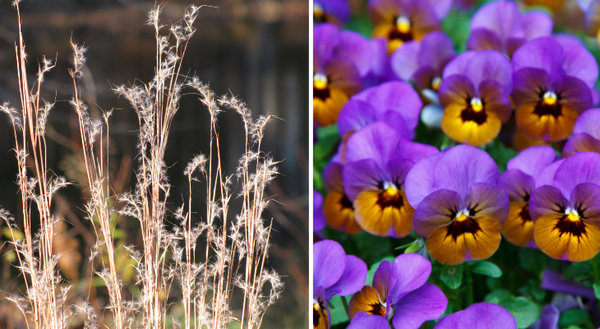
With over 400,000 species of plants in the world, one might wonder which ones are the best to grow in your garden or landscape. Many plant associations select a “Plant of the Year” using rigorous criteria to highlight plants they feel are deserving of the title. Consider these plants when planning your garden or looking for something new to grow this year.
In 2022, Viola has earned the top spot as Herb of the Year as recognized by the International Herb Association. Members of the genus Viola, including pansies, violets, and Johnny jump ups, are cool-season plants that grow best during the cooler temperatures of spring and fall. As the weather warms in late May and June, many cool-season plants will fade out and stop blooming but can be moved to a cool, shady place in the garden to extend their growing season.
Violas with brightly colored blooms that resemble cheerful faces peeking out of the foliage make a great addition to any early-season container or garden plantings. Blooms can be found in a variety of colors, including solids, bicolor, and mixes.
A bonus to including pansies or violets in the garden, the flowers can be harvested and added as a colorful edible garnish to soups, salads, and desserts. They can also be candied for a sweet treat. Just make sure any flowers you plan to eat are raised without chemical treatment.
Aptly named, little bluestem, (Schizachyrium scoparium and cultivars) earned the honors of Plant of the Year in 2022. Displaying fine-textured blue-green summer foliage, this selection, by the Perennial Plant Association, is noted for being sun-loving, drought-tolerant, low maintenance, dependable, and a source of year-round interest.
This Illinois native thrives in sunny locations but grows in a wide range of growing conditions, including poor soil and drought conditions. Depending on the cultivar, the upright growing mound reaches 4-5 feet tall. When used in the landscape, it creates the biggest impact when planted in large groupings mixed with other perennials and shrubs.
Adding year-round interest to the landscape with its changing foliage makes little bluestem a garden favorite. As new growth appears in your spring garden, have patience, little bluestem is a warm-season grass; new foliage will begin growing from the base of the plant after the air and soil temperatures warm up in later spring. By the warmer months of June through September little bluestem will steal the show! In August, small flowers turn into clusters of white fluffy seed heads that float above the foliage. After a frost, the foliage transitions into a gorgeous bronze-orange that persists into winter, adding unique color, texture, and interest in the winter landscape.
Little bluestem is also a host plant for nine different skipper butterflies, offering habitat to lay their eggs and a source of food. The winter foliage offers a place for birds, insects, and small mammals to stay protected from the cold temperatures and offers them food and shelter too.
PHOTO CREDIT: Little Bluestem and Viola Side-by-Side, Canva
ABOUT THE AUTHOR: Brittnay Haag is a Horticulture Educator with University of Illinois Extension, serving Livingston, McLean, and Woodford Counties. Her work focuses on youth horticulture education, specifically through school gardens and Jr. Master Gardener programs. Brittnay provides leadership for three county Master Gardener programs and is responsible for developing community programs and providing expertise in horticulture and environmental sciences.